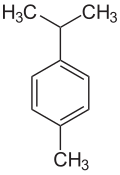Top Qs
Timeline
Chat
Perspective
P-Cymene
Chemical compound From Wikipedia, the free encyclopedia
Remove ads
p-Cymene is a naturally occurring aromatic organic compound. It is classified as an alkylbenzene related to monocyclic monoterpenes.[3] Its structure consists of a benzene ring para-substituted with a methyl group and an isopropyl group. p-Cymene is insoluble in water, but miscible with organic solvents.
Remove ads
Isomers and production
In addition to p-cymene, two less common geometric isomers are o-cymene, in which the alkyl groups are ortho-substituted, and m-cymene, in which they are meta-substituted. p-Cymene is the only natural isomer, as expected from the terpene rule. All three isomers form the group of cymenes.
Cymene is also produced by alkylation of toluene with propene.[4]
Related compounds
It is a constituent of a number of essential oils, most commonly the oil of cumin and thyme. Significant amounts are formed in sulfite pulping process from the wood terpenes.
p-Cymene is a common ligand for ruthenium. The parent compound is [(η6-cymene)RuCl2]2. This half-sandwich compound is prepared by the reaction of ruthenium trichloride with the terpene α-phellandrene. The osmium complex is also known.[5]
Hydrogenation gives the saturated derivative p-menthane.
Remove ads
References
Wikiwand - on
Seamless Wikipedia browsing. On steroids.
Remove ads




